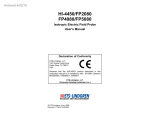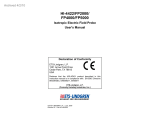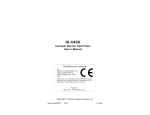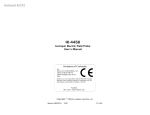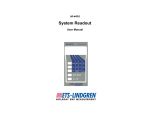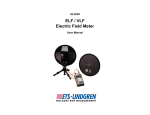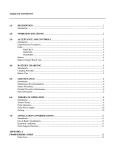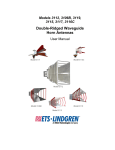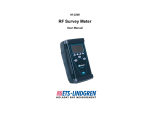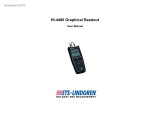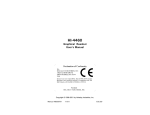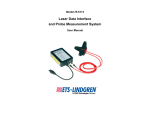Download Broadband Isotropic Field Probe - ETS
Transcript
Model HI-4433 Broadband Isotropic Field Probe User Manual This page intentionally left blank. ii | ETS-Lindgren L.P. reserves the right to make changes to any product described herein in order to improve function, design, or for any other reason. Nothing contained herein shall constitute ETS-Lindgren L.P. assuming any liability whatsoever arising out of the application or use of any product or circuit described herein. ETS-Lindgren L.P. does not convey any license under its patent rights or the rights of others. © Copyright 1993–2009 by ETS-Lindgren L.P. All Rights Reserved. No part of this document may be copied by any means without written permission from ETS-Lindgren L.P. Trademarks used in this document: The ETS-Lindgren logo is a trademark of ETS-Lindgren L.P. Revision Record | HI-4433 Series Probe, MANUAL | Part #600056, Rev. K Revision Description Date Initial Release October, 1993 A Revised September, 1994 B Revised June, 1995 C Added Probes September, 1995 D Revised August, 1996 E Changed Charger October, 1997 F Added CE Label October, 1997 G Revised January 1998 H Changed Charger Specs August, 1999 I Changed Area Code February, 2000 J Revised August, 2005 | iii Revision Updated branding: Revised to meet Style Guide specifications; reformatted to half-size; PIB included with release K iv Description | Date March, 2009 Table of Contents Notes, Cautions, and Warnings .............................................. vii Introduction ................................................................................ 9 ETS-Lindgren Product Information Bulletin ................................................. 10 Maintenance ............................................................................. 11 Maintenance Recommendations ................................................................. 11 Annual Calibration ....................................................................................... 11 Replacement and Optional Parts ................................................................. 12 Upgrade Policies .......................................................................................... 13 Service Procedures ..................................................................................... 13 Specifications ........................................................................... 15 General Specifications ................................................................................. 15 H-Field Probes ............................................................................................. 16 HI-4433-HCH ............................................................................................... 16 HI-4433-LFH ................................................................................................ 16 HI-4433-CH .................................................................................................. 17 E-Field Probe Specifications ........................................................................ 17 HI-4433-STE ................................................................................................ 17 HI-4433-GRE ............................................................................................... 18 HI-4433-MSE ............................................................................................... 18 Practical Application and Use ................................................ 19 System Theory ............................................................................................. 19 Automatic Zero ............................................................................................ 19 Probe Power Supply .................................................................................... 20 Application Considerations .......................................................................... 20 HI-4416 Hand Held Readout ............................................................... 21 HI-4413P Fiber Optic Interface ............................................................ 22 Operation .................................................................................. 23 Xmit/Rcv ...................................................................................................... 23 ARM/OFF ..................................................................................................... 24 Charger ........................................................................................................ 24 Assembling the Probe .................................................................................. 26 Appendix A: Warranty ............................................................. 29 | v Appendix B: EC Declaration of Conformity .......................... 31 Appendix C: Series H-491198-36 Battery Charger for NiCd Batteries .................................................................................... 33 Safety Precautions ....................................................................................... 33 Introduction .................................................................................................. 33 Battery Life ................................................................................................... 34 Charging a Battery ....................................................................................... 34 Specifications ............................................................................................... 36 Maintenance Recommendations ................................................................. 37 Appendix D: HI-4433 Operating Protocols ............................ 39 vi | Notes, Cautions, and Warnings Note: Denotes helpful information intended to provide tips for better use of the product. Caution: Denotes a hazard. Failure to follow instructions could result in minor personal injury and/or property damage. Included text gives proper procedures. Warning: Denotes a hazard. Failure to follow instructions could result in SEVERE personal injury and/or property damage. Included text gives proper procedures. See the ETS-Lindgren Product Information Bulletin for safety, regulatory, and other product marking information. | vii This page intentionally left blank. viii | Introduction The HI-4433 series comprises a family of battery-operated broadband radio frequency (RF) isotropic field probes designed for use in making RF exposure measurements in the vicinity of broadcast facilities and industrial RF sources. These probes use optical isolation to minimize field perturbation during measurements. Each probe in this series has characteristics that optimize its performance for a particular application. Model number differentiates individual probes for example HI-4433-XXX, where XXX defines the specific probe. Each HI-4433 series probe assembly consists of a spherical casing containing the sensor mounted on one end of a shaft. The other end of the shaft is attached to an extrusion that houses the electronics. The sensor and electronics housing operate, and are calibrated, as a unit. Since the appearance and layout of the electronics housing are the same for all probes in this series, both the probe assembly and the housing are coded with identical serial numbers to prevent mismatch. HI-4433 series probes measure the field strength in each of three axes. They perform a vector addition calculation on the readings and send the result to the readout via a fiber optic cable. Data from each axis can be viewed individually, or can be combined. The measurement capability and frequency response of HI-4433 series probes depend upon which model is selected. In addition, both magnetic and electric field probes are available. Introduction | 9 ETS-Lindgren Product Information Bulletin See the ETS-Lindgren Product Information Bulletin included with your shipment for the following: 10 • Warranty information • Safety, regulatory, and other product marking information • Steps to receive your shipment • Steps to return a component for service • ETS-Lindgren calibration service • ETS-Lindgren contact information | Introduction Maintenance Before performing any maintenance, follow the safety information in the ETS-Lindgren Product Information Bulletin included with your shipment. WARRANTY Maintenance of the HI-4433 Broadband Isotropic Field Probe is limited to external components such as cables or connectors. To prevent electrical shock, do not remove cover. Warranty may be void if the housing is opened. If you have any questions concerning maintenance, contact ETS-Lindgren Customer Service. Maintenance Recommendations Maintenance of the HI-4433 probe is limited to external components such as cables or connectors. Annual Calibration The HI-4433 probe assembly (sensor and electronics housing) requires an annual calibration check to verify that they are performing within specifications. See the Product Information Bulletin included with your shipment for information on ETS-Lindgren calibration services. Maintenance | 11 Replacement and Optional Parts Following are the part numbers for ordering replacement or optional parts for the HI-4433 Broadband Isotropic Field Probe. Replacement Parts Part Description Part Number Battery Pack, 3.6 VDC, H-491038 Rechargeable Standard Fast Charger (115/230 H-491198-36 Volt) Cable, Fiber Optic, Glass, 2 Meter H-491106-xx (where “xx” = length”) Probe Cover (2 required) H-470286A Handle Assembly H-491001 HI-4433 User Manual H-600056 Shipping Carton H-390066 Optional Parts Part Description 12 Part Number Tripod, Dielectric, HI-4433 H-491009 Fiber Optic/RS232 Interface HI-4413P ProbeView EMF Analysis Software ProbeView II Digital Remote Readout HI-4416 Carrying Case H-491083 | Maintenance Upgrade Policies Periodically, probes are upgraded to enhance functionality. Contact ETSLindgren Customer Service for the upgrade status of your probe. Service Procedures For the steps to return a system or system component to ETS-Lindgren for service, see the Product Information Bulletin included with your shipment. Maintenance | 13 This page intentionally left blank. 14 | Maintenance Specifications General Specifications • Overall Calibration Accuracy +2/-3 dB* • At calibration points ±0.5 dB* *Absolute accuracy to NIST ± 1.0 dB Isotropicity ± 0.5 dB Linearity ±0.5 dB • Operating Temp. 10ºC to 40ºC (50º F to 104ºF) Environmental • Humidity 5% to 95%* *relative humidity, non-condensing Fiber Optic Cable Connector Standard FSMA 3.6 VDC, 14000mA-h rechargeable Nickel- Battery Cadmium (NiCd), 20 hours of continuous operation Battery Charger Size 115/230 VAC, approximately 1 hour • Length* 559mm (22.0 in.) • Probe Diameter 102mm (4.0 in.) • Weight* 0.57 kg (20 oz) *Including electronics housing Probe Mount ¼ - 20 UNC tapped hole (internal thread) in base of probe Specifications | 15 H-Field Probes HI-4433-HCH Ranges 0.1, 0.3, 1.0, 3.0 A/m full scale Frequency Response 5.0 MHz to 300 MHz See General Specifications table for additional information. HI-4433-LFH Ranges 1.0, 3.0, 10.0, 30.0 A/m full scale Frequency Response 0.3 MHz to 30.0 MHz See General Specifications table for additional information. 16 | Specifications HI-4433-CH Ranges 0.3, 1.0, 3.0, 10.0 A/m full scale Frequency Response 5.0 MHz to 300 MHz See General Specifications table for additional information. E-Field Probe Specifications HI-4433-STE Ranges 100, 300, 1000, 3000 V/m full scale Frequency Response 0.5 MHz to 5.0 GHz See General Specifications table for additional information. Specifications | 17 HI-4433-GRE Ranges 10, 30, 100, 300 V/m full scale Frequency Response 0.5 MHz to 5.0 GHz See General Specifications table for additional information. HI-4433-MSE Ranges 30, 100, 300, 1000 V/m full scale Frequency Response 0.5 MHz to 5.0 GHz See General Specifications table for additional information. 18 | Specifications Practical Application and Use Before connecting any components, follow the safety information in the ETS-Lindgren Product Information Bulletin included with your shipment. System Theory HI-4433 series Broadband RF Probes utilize a microprocessor for intelligent operation and control. Their self-contained power supply employs a 3.6 VDC NiCd battery, which provides up to 20 hours of continuous operation. For each axis, the probe measures the radio frequency signal level and generates a linearized reading of this measurement. A vector addition is performed on these three readings: the resultant is transmitted to the readout over glass fiber optic cables. Receiver commands to the probe consist of the following: • • • Send reading • Set sleep timer Read battery • Switch range voltage • Read temperature Zero • Enable axis Automatic Zero This feature eliminates the need for internal zero adjustment and eliminates the temperature drift problems associated with other instrumentation. The automatic continuous zero also allows the operator to use the meter immediately upon power-up. Also, it is not necessary to place the meter in a zero field environment to check its zeroing. Practical Application and Use | 19 In addition to the inputs from the three axes, HI-4433 series probes utilize a fourth input called the Autozero channel. This is a redundant channel identical to the three axis channels except that, instead of being driven by a dipole, it is terminated (in the probe head) by a carbon resistor. This resistor simulates the zero-bias impedance of the Schottky diode in series with the high resistance feed line; it is also subject to the same temperature variations as the feed lines of the other three channels. Probe Power Supply A sealed rechargeable 3.6 VDC NiCd battery, which drives both the analog and digital power supplies, powers HI-4433 series probes; separate power sources provide isolation between the analog and digital circuitry. With the probe switch in the ARM position, battery voltage is applied to the power switch, which routes this voltage to the power control and the switching power supply, enabling the microprocessor. This power supply does not shut off automatically. Always turn the power supply off when the probe is not in use. Application Considerations Resolution Limitations Limitations in probe resolution may result in a non-zero reading when the receiver is zeroed. If this occurs, it does not necessarily mean either that there is a problem with the receiver or that your readings are inaccurate. Receiver linearity is specified as + 0.5 dB full scale: in addition, the variance of the A/D converter is + 2 least significant bits. When using the most sensitive range on a given probe, these specifications create the possibility that, under zero field conditions, the receiver may display a non-zero value. Probe Support Structures It is very important to keep conductive objects away from the HI4433. Any such objects in the proximity of the probe may distort the near field and compromise measurement accuracy. If your application requires measurements from a fixed position, always mount the probe on a non-metallic platform, using non-metallic screws. 20 | Practical Application and Use Optional Probe Interface/Readout The probe provides data to the readout via either a short form or long form output word. Commands to the probe use these same word forms. See Appendix B for details on the format for both out put words. HI-4416 HAND HELD READOUT The HI-4416 provides a digital display and data logging capabilities as well as optical isolation when a hand-held readout is desired. Practical Application and Use | 21 HI-4413P FIBER OPTIC INTERFACE For limited, specialized applications, you may use any computer with an RS232 serial port to communicate directly with the HI-4433 series probes via ETS-Lindgren’s optional HI-4413P Fiber Optic/RS232 Interface. 22 | Practical Application and Use Operation Before connecting any components, follow the safety information in the ETS-Lindgren Product Information Bulletin included with your shipment. A switch, two fiber optic connectors and a battery charger connector are mounted on the HI-4433 electronics housings. Xmit/Rcv The fiber optic cable assembly from the receiver is attached to the probe via two connectors. The cables are color-coded: white for XMIT, yellow for RCV. Identically colored dots are located on the electronics housing adjacent to these connectors. Ensure that each cable is attached to the proper probe connector. When the fiber optic cables are not attached, always cover the probe connectors with the protective plastic covers supplied with the unit, or with similar material. This prevents dirt or other contaminants from entering the connector and causing communication problems. Operation | 23 ARM/OFF The ARM/OFF switch activates and deactivates the probe. In the ARM position, the probe is powered by its internal 3.6 VDC NiCd battery: in the OFF position, the probe is inactive. To prolong battery life, set the ARM/OFF switch to OFF at the end of a test sequence or when the probe is not in use. Charger Each HI-4433 probe contains a rechargeable nickel-cadmium (NiCd) battery. A fully-charged battery (nominal output voltage of 3.6 VDC) provides up to 17 hours of continuous operation. ETS-Lindgren charges the internal NiCd battery of the HI-4433 at the factory in order to calibrate the probe prior to shipment. While every effort is made to ensure that your probe arrives ready to use, we cannot guarantee that this will be the case. Always check the condition of the battery prior to making any measurements. A standard fast charger is supplied with the HI-4433. When charging is complete, the fast charger acts as a trickle charger. 24 | Operation Charging Procedure Begin by plugging the charger into a suitable AC source. Next, set the probe switch to OFF. Insert the plug on the charger cable into the probe's CHARGER jack. The battery is now charging. Charging may take approximately one hour, depending on how deeply the batteries are discharged. When charging is complete, the charger will automatically begin a trickle charge and will continue to do so until the probe is disconnected. Tips NiCd batteries have several characteristics that can affect both their performance and operating life. The following tips advise you how to take advantage of these characteristics to get the most out of your probe’s battery. • Although NiCd batteries are rated for operation in temperatures from -20ºC to +65ºC (-4ºF to +140ºF), operating the probe in extreme temperatures will reduce operating time significantly. The optimum operating temperature range for these batteries is +20ºC to +30ºC (+68ºF to +86ºF). • The battery in the HI-4433 probe does not require periodic deep discharges to reverse the capacity depleting memory effect caused by repeated shallow discharges; however, undercharging can reduce battery capacity. Therefore, after the charging procedure is complete, be sure that the battery is fully charged before resuming field operation. • If the battery exhibits low terminal voltage during charging, or if it appears unable to acquire or maintain an appreciable charge, individual cells in the battery may be shorted or damaged. If, for any reason, your battery needs replacement, contact ETS-Lindgren Customer Service for assistance. Operation | 25 Assembling the Probe Each HI-4433 series probe assembly consists of a spherical casing containing the senor mounted on one end of a shaft and an extrusion that houses the electronics. The sensor and electronics housing operate, and are calibrated, as a unit. Since the appearance and layout of the electronics housing are the same for all probes in this series, both the probe assembly and the housing are coded with identical serial numbers to prevent mismatch. To begin assembly, locate the probe and the corresponding probe housing. Position the alignment arrows on the probe and housing so they are lined up, and then gently press the probe into the housing. 26 | Operation Pull the collar on the housing up to the threads on the probe and twist to begin tightening. Turn the collar until the threads on the probe are covered. Be careful not to overtighten. Operation | 27 This page intentionally left blank. 28 | Operation Appendix A: Warranty See the Product Information Bulletin included with your shipment for the complete ETS-Lindgren warranty for your HI-4433 Broadband Isotropic Field Probe. DURATION OF WARRANTIES FOR HI-4433 BROADBAND ISOTROPIC FIELD PROBE All product warranties, except the warranty of title, and all remedies for warranty failures are limited to one year. Product Warranted Duration of Warranty Period HI-4433-xxx 1 Year Warranty | 29 This page intentionally left blank. 30 | Warranty Appendix B: EC Declaration of Conformity EC Declaration of Conformity | 31 This page intentionally left blank. 32 | EC Declaration of Conformity Appendix C: Series H-491198-36 Battery Charger for NiCd Batteries The HI-4422 Field Probe contains a Nickel Cadmium (NiCd) battery, and uses the Series H-491198-36 Battery Charger. SAFETY PRECAUTIONS Before operating the Series H-491198-36 Battery Charger, see General Safety Considerations on page Error! Bookmark not defined.. INTRODUCTION The H-491198-36 Nickel-Cadmium (NiCd) Battery Charger is a dual power source battery charger. It charges 3.6 volt 1400 mAH NiCd batteries and is powered by 120-240 VAC line power or 12.5 VDC. The H-491198-36 Battery Charger uses a -(dV)/(dT) negative delta V technique to determine when the battery is fully charged, which is typically one hour. With this technique, the charge state of the battery has no effect other than shortening the charge time. Housed in a rugged enclosure, power enters the battery charger through a power entry module, which contains the fuses, or an optional cigarette lighter plug adapter. The front face of the battery charger displays LEDs that provide the operating status. The battery charger connects to the device being charged through a short cord terminated with a power jack. An integrated circuit within the battery charger monitors the battery voltage and controls the charging functions according to the charge state of the battery. Series H-491198-36 Battery Charger | 33 BATTERY LIFE A fully-charged battery (nominal output voltage of 3.6 VDC) provides up to 20 hours of operation. When the battery has discharged to 3.3 VDC, the Field Probe is still operational, but the battery needs charging. When the voltage drops below 3.18 VDC, measurement accuracy will be compromised by further operation. Follow these recommendations to ensure maximum battery life and optimum testing performance: • Operate the Field Probe only within the optimum operating temperature range of +20ºC to +30ºC (+68ºF to +86ºF). Although NiCd batteries are rated for operation in temperatures from -20ºC to +65ºC (-4ºF to +140ºF), operating the Field Probe at temperature extremes reduces the operating time of the batteries. • Make sure the battery is fully charged before resuming operation. The battery does not require periodic deep discharges to reverse the effect caused by repeated shallow discharges, but undercharging can reduce battery capacity. If the battery exhibits low terminal voltages during charging, or if it appears unable to acquire or maintain a charge, individual cells in the battery may be shorted or damaged. If your battery needs replacement for any reason, contact ETS-Lindgren Customer Service. CHARGING A BATTERY 1. Make sure the power switch on the Field Probe is set to the OFF position or the battery will not charge. 2. Connect the battery charger to the proper power source, and then connect the charger to the charger jack on the Field Probe. Charging takes approximately one hour, depending on the degree of battery discharge. When charging is complete, the battery charger automatically enters into a trickle charge, and continues until the Field Probe is disconnected. Never attempt to recharge a non-rechargeable battery. 34 | Series H-491198-36 Battery Charger CHARGING INDICATORS The following LEDs are located on the front of the battery charger: • POWER ON (green)—Indicates the battery charger is connected to the AC power source. • NO BATTERY (amber)—Indicates the battery charger does not detect a battery. • PENDING (amber)—Indicates the battery charger detects a battery. Before fast charging can begin, the battery voltage must fall within predetermined acceptable limits. A pulse-trickle charge is provided to bring a depleted battery to a valid charge prior to fast charge. • CHARGING (amber)—Indicates the voltage pre-qualification condition has been met, and fast charge has started. • COMPLETE (green)—Indicates a fast charging peak voltage is detected. The Field Probe can remain connected to the battery charger indefinitely while in this maintenance mode. Series H-491198-36 Battery Charger | 35 SPECIFICATIONS BATTERY CHARGER SPECIFICATIONS The H-491198-36 charger may be powered by standard line voltage (110 - 240 Vac, 50 - 60 Hz) or by an optional automobile cigarette lighter plug (12.5 Vdc). Power Main: IEC filtered AC power input module 110-240 VAC, 500 mA max, 50-100 Hz Alternate: Automobile cigarette lighter to 2 mm power plug adapter cord, 12.5 Vdc, 100 mA Fuses: 250 volt, 1.0 Amp, Type T (5 mm x 20 mm) Output Open Circuit Voltage: 15 Vdc Fast Charge Pending Current: 60 mA Fast Charge Current: Pulsed Trickle Charge Current: Output Voltage (During Fast Charge): NiMH Battery: 1400 mA 50 mA 3 - 6 Vdc • 3.6 volt 3 cell NiCd Battery, 1400 mAH (rapid charge cells, 1.2 volts/cell) • ETS-Lindgren Part #491038 36 | Series H-491198-36 Battery Charger Environmental Operating Temperature: 10ºC to 40ºC 50ºF to 104ºF Humidity: 5% to 95% relative humidity, non-condensing MAINTENANCE RECOMMENDATIONS • • Operate the battery charger with care. There are no user serviceable parts inside the battery charger. Opening the battery charger housing may void your warranty. REPLACING THE FUSE Disconnect the battery charger from power before replacing a fuse. If the battery charger fails to operate, check for a blown fuse inside the power entry module. A blown fuse must be replaced with the same value and type of fuse, or an unsafe condition may result. Use only 250 Volt, 1.0 Amp, Type T (5 mm x 20 mm) fuses. To replace a fuse: 3. Two fuses are located in the fuse drawer in the power input module. Use a screwdriver to open the drawer. 4. The fuse towards the outside of the drawer is the spare. Remove the spare fuse from the module. Series H-491198-36 Battery Charger | 37 5. Replace the blown fuse with the spare fuse. 6. Slide the fuse drawer back into the module. Make sure that the drawer snaps securely into its locked position. 38 | Series H-491198-36 Battery Charger Appendix D: HI-4433 Operating Protocols The following information assumes that the optional HI-4413P Fiber Optic/RS232 Interface was purchased and is capable of communicating directly with an HI4433 probe via computer. No system readout is required when using this configuration. COMMUNICATION PROTOCOL Data Type: RS-232 Serial Data Mode: Asynchronous Word Length: 7 bit Parity: Odd Stop Bits: 1 Data Rate: 9,600 baud INFORMATION TRANSFER PROTOCOL The HI-4433 series probes only respond to commands from another device; they transmit no data without first receiving instructions to do so. COMMAND STRUCTURE Probe Description Probe Response Command Axxx Axis enable/disable. • x=E (enable) or D (disable) • xxx order=X axis, Y axis, Z axis B Read battery voltage. Bxx.xx, • xx.xx=battery voltage Series H-491198-36 Battery Charger | 39 Probe Description Probe Response Command Dx Read probe data. For D1 command: • x=1, enables short form output output • x=2, enables long form output Dxx.xxuuu, the short form • xx.xx=the reading, and the position of the decimal point depends upon the range setting of the Field Probe • uuu=units • _V_ = V/m, mW2 = mW/cm², _V2 = [V/m]² (underscore indicates a space) For D2 command: Dxx.xxuuurrrobaaa, the long for output • xx.xx=the reading, as described for D1 • uuu=units, as described for D1 • rrr=recorder out value, a three-digit ASCII number from 0 to 255 • o=over range indicator: N=ok, O=over range • b=battery status: N=safe operating level, W=warning level, F=fail level • aaa=axis enable: E=enabled, D=disabled, axis order=X, Y, Z 40 | Series H-491198-36 Battery Charger Probe Description Probe Response Command Rx Set range. Rx, where x is the range • x=1, 2, 3, 4, or N (next • x=returns the range range) currently in use • x=1, 2, 3, 4 enables the selected range x=N sets the Field Probe to the next higher range Tx Read temperature. • x=C or F For TF command: Txxx • xxx=temperature in degrees in Fahrenheit For TC command: Txxx • xxx=temperature in degrees in Centigrade Ux Set unit type. • x=1, 2, 3, or N (next unit) • 1=V/m • 2=mW/cm² • 3=[V/m]² Z Zero Null Send the ASCII null This is a special command that character. can be used as the initial command to the Field Probe after it is turned on. The probe responds with N. Series H-491198-36 Battery Charger | 41 PROBE ERROR OUTPUT If an error occurs, the probe will respond with one of the following strings. These strings begin with a colon and end with a carriage return. E1 Communication error (for example, overflow) E2 Buffer full error; too many characters contained between the start character and carriage return sequence 42 E3 Received command is invalid E4 Received parameter is invalid E5 Hardware error (for example, EEPROM failure) E6 Parity error | Series H-491198-36 Battery Charger











































